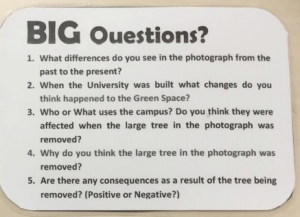“Geo-Stache”: Observing and responding to landscape change; 1960 – 2016

Photo of the campus at the time of construction in the 1960s

Photo of the same location now
“Geo-Stache” is a temporary ‘waymarked’ geocache which has been hidden at the base of a tree, in a discrete location beneath the bridge on the south side of the Stirling University campus. The objective here is to provide an amusing search for the pupils to “kick off” the cache. The site is easily accessed from a public footpath and due to the even terrain, is highly suitable for the associated tasks. This site was selected by looking at archived photographs from the 1960’s that were sourced from the University Library. These photographs not only provided a snapshot of the University Campus at that time but also showed the transformation of this area from managed grassland, prior to the construction of the University in 1967 to how it is today.

The pupils were given a photograph to act as a motivational hook, and then had to work with their peers to locate the position of where it was captured. This was in close proximity to the geocache, which encouraged pupils to engage with their surrounding environment by reacting to a stimulus, making this cache place-essential.

After navigating to the photographer’s location, the ‘BIG Questions’ are then used to facilitate enquiry-based learning. The questions provide the opportunity for the pupils to have an open-ended discussion at a level relevant to their own knowledge and understanding.

Due to the nature of a collaborative discussion, incidental learning and scaffolding occurring between peers, this allowed for confidence and self-esteem to be built. The nature of this cache lends itself to first and second level (CFE) pupils.
The second activity links the ‘BIG questions’ to the place. It involves the pupils measuring the age of one of the trees that is present today (also captured in the 1960’s photograph). This can stimulate more discussion on why particular trees have been removed. In the cache there is a measuring tape, string and a calculator alongside a set of instructions detailing the process of the calculation. This draws on the sustainability focus which explores the impact of lost green space and more specifically the removal of trees (associated environmental effects).
This cache can be an entry point for various science concepts including; sustainability (development), land management/change (to encourage sustainability, links to human geography) and habitats (both trees and managed grassland). Upon completion of this cache pupils walked away with a deepened understanding of the scientific concept, ‘the effect of changing land use patterns on ecological systems’. Although complex, this is accessible for all through the use of a real-life context, collaborative discussions and a practical based activity. This collaborative learning style allows for key learning points to be communicated, an example of this is:
“If more trees are removed then where will the birds and squirrels live?”
This informal conversation raised the sustainability link for all. Therefore the cache should be presented to small groups of pupils for maximum engagement.
The cache promote further enquiry-based learning out in the field as well as back in the classroom potentially looking at their local environment or just seeking out areas of greenspace changes further afield. Due to the accessible nature of this cache both in location and tasks, it can be completed regardless of weather, time of year and ability which results in there being no obvious barriers to learning.
Alan Atkinson and Kirsty MacKenzie.
Curriculum for Excellence: outcomes and experiences …
Science: Planet Earth
Through carrying out practical activities and investigations, I can show how plants have benefited society. SCN 2-02b
Social Studies: People, place and environment
Having explored the landscape of my local area, I can describe the various ways in which land has been used. SOC 1-13a
I can discuss the environmental impact of human activity and suggest ways in which we can live in a more environmentally-responsible way. SOC 2-08a



